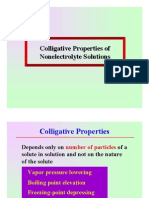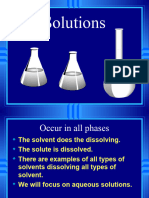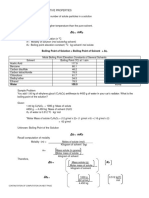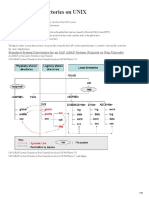0 ratings0% found this document useful (0 votes)
92 viewsColligative Properties
Colligative Properties
Uploaded by
Joana DomingoThis document discusses four colligative properties of solutions:
1. Vapor pressure lowering and boiling point elevation - Adding a solute lowers vapor pressure and raises the boiling point of a solvent. The higher the solute concentration, the greater the effect.
2. Freezing point depression - Adding a solute lowers the freezing point of a solvent. The higher the solute concentration, the greater the freezing point depression.
3. Osmotic pressure - The pressure required to prevent osmosis, or diffusion of solvent into the solution. Higher solute concentrations yield higher osmotic pressures.
4. A sample problem calculates the boiling point and freezing point of a sucrose solution using the concepts of boiling
Copyright:
© All Rights Reserved
Available Formats
Download as DOCX, PDF, TXT or read online from Scribd
Colligative Properties
Colligative Properties
Uploaded by
Joana Domingo0 ratings0% found this document useful (0 votes)
92 views1 pageThis document discusses four colligative properties of solutions:
1. Vapor pressure lowering and boiling point elevation - Adding a solute lowers vapor pressure and raises the boiling point of a solvent. The higher the solute concentration, the greater the effect.
2. Freezing point depression - Adding a solute lowers the freezing point of a solvent. The higher the solute concentration, the greater the freezing point depression.
3. Osmotic pressure - The pressure required to prevent osmosis, or diffusion of solvent into the solution. Higher solute concentrations yield higher osmotic pressures.
4. A sample problem calculates the boiling point and freezing point of a sucrose solution using the concepts of boiling
Original Description:
Grade 12 - STEM
General Chemistry 2
Copyright
© © All Rights Reserved
Available Formats
DOCX, PDF, TXT or read online from Scribd
Share this document
Did you find this document useful?
Is this content inappropriate?
This document discusses four colligative properties of solutions:
1. Vapor pressure lowering and boiling point elevation - Adding a solute lowers vapor pressure and raises the boiling point of a solvent. The higher the solute concentration, the greater the effect.
2. Freezing point depression - Adding a solute lowers the freezing point of a solvent. The higher the solute concentration, the greater the freezing point depression.
3. Osmotic pressure - The pressure required to prevent osmosis, or diffusion of solvent into the solution. Higher solute concentrations yield higher osmotic pressures.
4. A sample problem calculates the boiling point and freezing point of a sucrose solution using the concepts of boiling
Copyright:
© All Rights Reserved
Available Formats
Download as DOCX, PDF, TXT or read online from Scribd
Download as docx, pdf, or txt
0 ratings0% found this document useful (0 votes)
92 views1 pageColligative Properties
Colligative Properties
Uploaded by
Joana DomingoThis document discusses four colligative properties of solutions:
1. Vapor pressure lowering and boiling point elevation - Adding a solute lowers vapor pressure and raises the boiling point of a solvent. The higher the solute concentration, the greater the effect.
2. Freezing point depression - Adding a solute lowers the freezing point of a solvent. The higher the solute concentration, the greater the freezing point depression.
3. Osmotic pressure - The pressure required to prevent osmosis, or diffusion of solvent into the solution. Higher solute concentrations yield higher osmotic pressures.
4. A sample problem calculates the boiling point and freezing point of a sucrose solution using the concepts of boiling
Copyright:
© All Rights Reserved
Available Formats
Download as DOCX, PDF, TXT or read online from Scribd
Download as docx, pdf, or txt
You are on page 1of 1
Colligative Properties Tb = Kbm b.
Calculate the boiling point The higher the concentration of
Properties of solutions elevation the solution the higher is the
They are dependent on the Tb = boiling point elevation Tb = Kbm osmotic pressure
number of solute particles that = (0.52oC/m) (0.058m) Osmosis
are dissolved in a given quantity Kb = boiling point elevation constant = 0.03oC A Greek word meaning “push”
of the solvent and not in their (0.512oC/m) A process in which the solvent
identity. c. Calculate the boiling point moves through a semipermeable
m = molal concentration Tb = boiling point of water + Tb membrane into the solution
1. Vapor Pressure Lowering = 100oC + 0.03oC
The presence of a solute lowers 3. Freezing point depression = 100.03oC Semipermeable membrane
the vapor pressure of the solvent The presence of solute Allows certain types of molecules
The presence of the solute with lowers the freezing point of Freezing point elevation to pass through while preventing
exert attraction on the solvent the solvent a. Calculate the molality the passage of other species in
molecules, thus decreasing their mole of solute solution.
m=
rate of escape Tf = Kfm kg of solvent
Higher concentration of the
solute added, the greater is Tf = freezing point elevation 4g
m=
decrease of vapor pressure 0.2 kg
Kf = freezing point constant m = 0.058 m
2. Boiling Point Elevation (1.86oC/m)
The boiling point of the solution b. Calculate the freezing point
is higher than the boiling point of m = molal concentration elevation
a pure solvent Tf = Kfm
The addition of a solute Sample Problem for boiling point = (1.86oC/m) (0.058m)
increases the boiling point of the elevation and freezing point depression = 0.11oC
solution
To bring the solution to its Find the boiling point and freezing point c. Calculate the freezing point
boiling point more heat is of a solution containing 4 g sucrose Tf = freezing point of water + Tf
o o
needed (C12H22O11) dissolved in 200 g of H2O. = 0 C + 0.11 C
= -0.11oC
Boiling point of a liquid Boiling point elevation
Is the temperature at which the a. Calculate the molality 4. Osmotic pressure
vapor pressure of the liquid and mole of solute The pressure needed to prevent
m=
its atmospheric pressure are kg of solvent osmosis from the pure solvent to
equal the solution
Boling point is directly 4g Related to the molar concentration
m=
proportional to the amount of 0.2 kg of the solution
solute added m = 0.058 m
You might also like
- Experiment 11 Boiling Point ElevationDocument2 pagesExperiment 11 Boiling Point ElevationHanna Gwyneth DollanoNo ratings yet
- TOEFL Writing TipsDocument27 pagesTOEFL Writing TipsBenjamin GordonNo ratings yet
- Dollano, HAnnaGwyneth - Experiment 11 Boiling Point ElevationDocument2 pagesDollano, HAnnaGwyneth - Experiment 11 Boiling Point ElevationHanna Gwyneth DollanoNo ratings yet
- Colligative PropertiesDocument4 pagesColligative PropertiesDECA JALUENo ratings yet
- Sifat Koligatif LarutanDocument10 pagesSifat Koligatif Larutanafif armadaniNo ratings yet
- PDF - Colligative Property 2Document1 pagePDF - Colligative Property 2Yakshit JunejaNo ratings yet
- Solution Ch2Document31 pagesSolution Ch2lavi3 scienceNo ratings yet
- Freezing Point DepressionDocument3 pagesFreezing Point DepressionFarid HossainNo ratings yet
- Physical Properties of SolutionsDocument23 pagesPhysical Properties of SolutionsMichael Conan MaglaqueNo ratings yet
- Calculation On BPE FPDDocument17 pagesCalculation On BPE FPDstephniedayaoNo ratings yet
- Colligative 1Document26 pagesColligative 1miguelcarlosavila81No ratings yet
- Colligative PropertiesDocument41 pagesColligative PropertieslaurencegaurinoNo ratings yet
- Colligative Properties of Nonelectrolyte SolutionsDocument40 pagesColligative Properties of Nonelectrolyte Solutionspogi69100% (5)
- 2 SolutionDocument32 pages2 Solutionamd279151No ratings yet
- Colligative PropertiesDocument3 pagesColligative PropertiesCarlo Joseph MoskitoNo ratings yet
- Calc. Molar Mass From Colligative Property DataDocument43 pagesCalc. Molar Mass From Colligative Property DatalaurencegaurinoNo ratings yet
- Target: Figure 1. Citrus Fruits Sprayed With WaterDocument7 pagesTarget: Figure 1. Citrus Fruits Sprayed With WaterGrace AmarNo ratings yet
- Stem08 Final LessonDocument22 pagesStem08 Final Lessonsunooyah95No ratings yet
- Colligative Prop. ContinuationDocument4 pagesColligative Prop. ContinuationBianca GeagoniaNo ratings yet
- Gen - Chem 2 Q3 Week 5 With QA Beta 1Document17 pagesGen - Chem 2 Q3 Week 5 With QA Beta 1Andrhea Peralta100% (1)
- Boiling Point Elevation1Document3 pagesBoiling Point Elevation1Nigatu MAmoNo ratings yet
- 3rd Qtr-2nd Long TestDocument2 pages3rd Qtr-2nd Long Testedward henry caoileNo ratings yet
- Changes in Vapour Pressure. (Vapour Pressure Lowering) : V - P Depends Only On The SolventDocument5 pagesChanges in Vapour Pressure. (Vapour Pressure Lowering) : V - P Depends Only On The SolventMarthy DayagNo ratings yet
- Colligative Properties of SolutionDocument8 pagesColligative Properties of SolutionJerome FernandezNo ratings yet
- Colligative Properties of SolutionDocument7 pagesColligative Properties of SolutionBianca GeagoniaNo ratings yet
- Colligative Properties: Nathaniel P. DugosDocument32 pagesColligative Properties: Nathaniel P. DugossololexzibNo ratings yet
- Molar Mass From Boiling Point Elevation or Freezing Point DepressionDocument1 pageMolar Mass From Boiling Point Elevation or Freezing Point DepressionNoreen Guiyab TannaganNo ratings yet
- Random Notes Class 12 ChemistryDocument87 pagesRandom Notes Class 12 Chemistryankitajamatia06No ratings yet
- Lec21607 +#+# (# (#?Document24 pagesLec21607 +#+# (# (#?Rylle PongaseNo ratings yet
- Solution Part 4Document92 pagesSolution Part 4abuthahir1.mcaNo ratings yet
- ColligativeColloids Y8h060ztDocument19 pagesColligativeColloids Y8h060ztNethania IreneNo ratings yet
- General ChemistDocument4 pagesGeneral ChemistKiyoshi TakeuchiNo ratings yet
- Chem FormulasDocument24 pagesChem FormulasReniela Dela PazNo ratings yet
- Colligative Properties. 11th LessonDocument24 pagesColligative Properties. 11th LessonEdward Czar PaniqueNo ratings yet
- Physical III UgDocument15 pagesPhysical III UgvenkatasanguNo ratings yet
- Study Material Chemistry 2022-23Document166 pagesStudy Material Chemistry 2022-23Akash Kumar UpadhyayNo ratings yet
- PT 2 - Dilution and Colligative Properties Worksheet-1Document4 pagesPT 2 - Dilution and Colligative Properties Worksheet-1Althea ErielNo ratings yet
- Simple Mixtures Colligative Properties: Chapter 7: SlideDocument32 pagesSimple Mixtures Colligative Properties: Chapter 7: SlideputriNo ratings yet
- Boiling Point ElevationDocument23 pagesBoiling Point Elevationopolla nianorNo ratings yet
- Colligative PropertiesDocument27 pagesColligative PropertiesKofoworola MikailNo ratings yet
- Solutions PT.3Document4 pagesSolutions PT.3TusharNo ratings yet
- Physical Properties of SolutionsDocument30 pagesPhysical Properties of SolutionsCalonanak Sithr2020No ratings yet
- HW - Colligative Properties of Solution G5Document4 pagesHW - Colligative Properties of Solution G5JOVINEIL DELA CRUZNo ratings yet
- 02 - Colligative PropertiesDocument46 pages02 - Colligative PropertiesamirNo ratings yet
- Lecture - 09 - Physical Properties of SolutionsDocument33 pagesLecture - 09 - Physical Properties of SolutionsDuy Do MinhNo ratings yet
- Mulungushi University-Colligative PropertiesDocument39 pagesMulungushi University-Colligative PropertiesLillian KakoleNo ratings yet
- Measuring SolutionsDocument49 pagesMeasuring Solutions23122005trangxinhNo ratings yet
- Colligative PropertiesDocument38 pagesColligative Propertiesomar mostafaNo ratings yet
- PT 2 - ChemDocument4 pagesPT 2 - ChemAlthea ErielNo ratings yet
- Chemistry ProjectDocument17 pagesChemistry ProjectYohanNo ratings yet
- 06 The Project 07 Theory 08 Experiment 12 Procedure 13 Observations 15 Calculation 16 Conclusion 19Document17 pages06 The Project 07 Theory 08 Experiment 12 Procedure 13 Observations 15 Calculation 16 Conclusion 19YohanNo ratings yet
- Colligative PropertiesDocument5 pagesColligative PropertiesMarc Nicholas ValdezNo ratings yet
- Colligative Properties of SolutionsDocument13 pagesColligative Properties of SolutionsRich AgustinNo ratings yet
- Capsule Class Xii-2023-24Document38 pagesCapsule Class Xii-2023-24rupadevi281110No ratings yet
- Chapter 12 SolutionsDocument30 pagesChapter 12 SolutionsAbdillah AlfikriNo ratings yet
- 5.notes .Dilutions - Colligative.FPD .BPEDocument2 pages5.notes .Dilutions - Colligative.FPD .BPEAmaris HopkinsNo ratings yet
- Formulae Solutions (Amit Sir) ParadiseDocument4 pagesFormulae Solutions (Amit Sir) Paradiseravitiwari5497No ratings yet
- Freezing Point Depression With Lab QuestDocument12 pagesFreezing Point Depression With Lab QuestiiiNo ratings yet
- AP Chemistry Problems - Freezing Point Depression and Other Solution Properties With AnswersDocument16 pagesAP Chemistry Problems - Freezing Point Depression and Other Solution Properties With AnswersCameron Kaye ColamboNo ratings yet
- BOILING POINT E-WPS OfficeDocument8 pagesBOILING POINT E-WPS OfficeOtaru kehindeNo ratings yet
- Research ReportDocument11 pagesResearch ReportJoana DomingoNo ratings yet
- Colligative Properties NotesDocument1 pageColligative Properties NotesJoana DomingoNo ratings yet
- Identifying and Analyzing ClaimsDocument11 pagesIdentifying and Analyzing ClaimsJoana DomingoNo ratings yet
- National Artists For LiteratureDocument29 pagesNational Artists For LiteratureJoana DomingoNo ratings yet
- Contemporary Philippine Arts From The Regions (CPAR) Notes For Second SemesterDocument2 pagesContemporary Philippine Arts From The Regions (CPAR) Notes For Second SemesterJoana Domingo0% (1)
- Movie ReviewDocument5 pagesMovie ReviewJoana DomingoNo ratings yet
- Development of Writing Across DisciplinesDocument11 pagesDevelopment of Writing Across DisciplinesJoana DomingoNo ratings yet
- Critical Reading: Jaybie Love S. de Vera Veronica Ocampo Mary Joan Aquino Argentina LopezDocument51 pagesCritical Reading: Jaybie Love S. de Vera Veronica Ocampo Mary Joan Aquino Argentina LopezJoana DomingoNo ratings yet
- 11 Warning Signs On An Impending LandslidesDocument9 pages11 Warning Signs On An Impending LandslidesJoana DomingoNo ratings yet
- SAP System Directories On UNIXDocument10 pagesSAP System Directories On UNIXDevender5194No ratings yet
- Specialty Guidelines For Forensic PsychologistsDocument8 pagesSpecialty Guidelines For Forensic PsychologistsJonathan ValdesNo ratings yet
- Automation Control: Department of Industrial Engineering, UET PeshawarDocument26 pagesAutomation Control: Department of Industrial Engineering, UET PeshawarZara SaharNo ratings yet
- 30:60:90 PlanDocument10 pages30:60:90 PlanSocrates VergaraNo ratings yet
- Triton Relays Normally Open Vs Normally Closed PDFDocument2 pagesTriton Relays Normally Open Vs Normally Closed PDFMariane LopesNo ratings yet
- Iec 62109-2Document13 pagesIec 62109-2egipts100% (1)
- #Masterdrives CUVC Eng Uusi DC-DCDocument35 pages#Masterdrives CUVC Eng Uusi DC-DCHồng ĐạtNo ratings yet
- Generalized Pythagoras TheoremDocument12 pagesGeneralized Pythagoras TheoremHavas JanosNo ratings yet
- PWV4 BS 001Document348 pagesPWV4 BS 001July HuaquistoNo ratings yet
- MSCHW!C010Document1 pageMSCHW!C010mjdeNo ratings yet
- Applied Mathematics Handout PDFDocument179 pagesApplied Mathematics Handout PDFcleous100% (1)
- UT Dallas Syllabus For Husl6390.001.10f Taught by Patricia Michaelson (Pmichael)Document3 pagesUT Dallas Syllabus For Husl6390.001.10f Taught by Patricia Michaelson (Pmichael)UT Dallas Provost's Technology GroupNo ratings yet
- Can AnalyzerDocument39 pagesCan Analyzerallaboutanalog100% (1)
- Steps To Improve Roads On Black Cotton SoilsDocument13 pagesSteps To Improve Roads On Black Cotton SoilsPerkresht PawarNo ratings yet
- Gerund and Gerund PhraseDocument25 pagesGerund and Gerund Phrasejrpasuquin01No ratings yet
- Polarography Introduction and History:: 1922 by The Czech Chemist Jaroslav Heyrovský (1890-1967)Document11 pagesPolarography Introduction and History:: 1922 by The Czech Chemist Jaroslav Heyrovský (1890-1967)Hira AnwarNo ratings yet
- Full Download The Extended Specimen: Emerging Frontiers in Collections-Based Ornithological Research 1st Edition Webster PDFDocument53 pagesFull Download The Extended Specimen: Emerging Frontiers in Collections-Based Ornithological Research 1st Edition Webster PDFmahupuegebo100% (2)
- Sodium ThiosulfateDocument8 pagesSodium ThiosulfateJakeNo ratings yet
- Behavioral Geneticsin Criminal Court NHBDocument4 pagesBehavioral Geneticsin Criminal Court NHBDabek DabNo ratings yet
- Writing A Publishable Paper-CampusDocument35 pagesWriting A Publishable Paper-Campuslienraserolf0% (1)
- ACT Report - Goulburn TRS Insulation - Jemena Gas NetworksDocument17 pagesACT Report - Goulburn TRS Insulation - Jemena Gas Networksmkash028No ratings yet
- The Challenge of An Urban World An Opportunitu For US Foreing AssistanceDocument35 pagesThe Challenge of An Urban World An Opportunitu For US Foreing AssistancelucasgarciacalixtoNo ratings yet
- MBA Interview Questions - Question Bank For MBA InterviewDocument4 pagesMBA Interview Questions - Question Bank For MBA InterviewsushilkgautamNo ratings yet
- CYK AlgorithmDocument29 pagesCYK AlgorithmDeJaVuNo ratings yet
- Strip FootingDocument10 pagesStrip FootingAzam Islam KhanNo ratings yet
- Shenyang Aerospace Mitsubishi Motors Engine Manufacturing Co., LTDDocument167 pagesShenyang Aerospace Mitsubishi Motors Engine Manufacturing Co., LTDAbel OviedoNo ratings yet
- Omala S4 GXV 220Document2 pagesOmala S4 GXV 220Aaron ChanNo ratings yet
- Dazzling Design Company ProfileDocument16 pagesDazzling Design Company ProfileAbdullah al shafiNo ratings yet
- DS Granichape MortierDocument2 pagesDS Granichape MortierfaridNo ratings yet


































































































